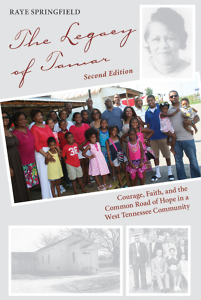A Family History Writ Large
Raye Springfield’s story is also the story of Haywood County, Tennessee
Some family stories rise past anecdote to the level of history. Case in point: the amazing tale documented in the newly released second edition of The Legacy of Tamar: Courage, Faith, and the Common Road of Hope in a West Tennessee Community by Nashville attorney Raye Springfield.
 The book, originally published in 2000, presents a five-generation examination of Haywood County, Tennessee, told through the experiences of one black family. Springfield’s own legal accomplishments—she has served as assistant general counsel for the Tennessee Board of Regents and assistant state attorney general, and was for fourteen years an administrative law judge—reflects the impressive family history she outlines in The Legacy of Tamar. The Taylor-Springfields were and remain a close-knit group determined not to let racism deprive them of the opportunities supposedly granted to all Americans by virtue of being born in this nation.
The book, originally published in 2000, presents a five-generation examination of Haywood County, Tennessee, told through the experiences of one black family. Springfield’s own legal accomplishments—she has served as assistant general counsel for the Tennessee Board of Regents and assistant state attorney general, and was for fourteen years an administrative law judge—reflects the impressive family history she outlines in The Legacy of Tamar. The Taylor-Springfields were and remain a close-knit group determined not to let racism deprive them of the opportunities supposedly granted to all Americans by virtue of being born in this nation.
Like many others in the area, Springfield’s family members endured vicious oppression and injustice, yet they also enjoyed personal triumphs and advancement. Their story spans many of the great events in twentieth-century history. Both world wars, for example, gave black soldiers from Haywood County the opportunity to see other parts of the world and societies not so rigidly stratified by color.
But primarily Springfield’s book spotlights Haywood Country—and by extension Brownsville, Tennessee—and its unique place within the state’s history. Despite outnumbering whites two to one, black residents endured for decades a status not greatly improved over abject slavery. The Taylor-Springfields occupied a special position in the county, nevertheless, because they were one of the very few black families who owned property outright. They also were smart enough to foresee coming societal changes, most notably the shift from rural to urban lifestyles, in time to adjust to the changes.
Every incident in The Legacy of Tamar illustrates how far blacks in Brownsville and Haywood County had come, but also how much further they and the nation still had to go:
After talking for a while, Lee or Tony would call out to him and ask, “What you think about that, Pops?” Sometimes they tried to get him to agree with them by asking, “Ain’t that right, Papa?” Tonnie just laughed. Once one of the boys said, “Pops, they tell me you voted in the last presidential election [1968]. You didn’t vote for Nixon, did you?” They knew that Tonnie and Opal had both registered and voted for the first time in the 1968 election. They both voted for the Democratic candidate, Hubert H. Humphrey, but the boys asked anyway.
 Of equal value is Springfield’s historical survey of Brownsville and the compelling story of her own family history. Readers vividly see the level of oppression that once existed and get an understanding of how blacks survived in spite of it, fighting it in differing ways as the times allowed. Tales of their success, family reunions, military service, and educational accomplishments reveal how this family, and by extension African-Americans everywhere, didn’t let hard times or bigotry kill their dreams. In the commentary and rhetoric of the youngest members of the Taylor-Springfield family readers encounter a vision of a future society where racial barriers don’t exist and where people interact with each other strictly as humans with different experiences to share and enjoy.
Of equal value is Springfield’s historical survey of Brownsville and the compelling story of her own family history. Readers vividly see the level of oppression that once existed and get an understanding of how blacks survived in spite of it, fighting it in differing ways as the times allowed. Tales of their success, family reunions, military service, and educational accomplishments reveal how this family, and by extension African-Americans everywhere, didn’t let hard times or bigotry kill their dreams. In the commentary and rhetoric of the youngest members of the Taylor-Springfield family readers encounter a vision of a future society where racial barriers don’t exist and where people interact with each other strictly as humans with different experiences to share and enjoy.
The central event in Springfield’s history is the 1940 abduction and murder of Elbert Williams, the nation’s first NAACP official to suffer this treatment at the hands of a white supremacist mob. He was killed for daring to be part of a voter-registration campaign. This event did not have the intimidating impact on either the Taylor-Springfield family or on Brownsville’s black citizens its perpetrators hoped. Instead of frightening them into submission, it galvanized them into unified and stalwart opposition to the status quo.
This second edition of The Legacy of Tamar brings the story into the new millennium. It’s now been seventy-five years since Williams’s murder, and there have been numerous changes in the area. While neither Brownsville nor America is free of racism, the voter registration campaign that cost Williams his life has been successful enough to allow for the election of a black mayor in 2014. There is also a special celebration—held on June 20, 2015—in honor of Elbert Williams that’s attended by both city and county leaders, as well as more than 500 people. The NAACP’s national president journeys to Brownsville for the ceremony, which includes a march to the cemetery where Williams was first buried in an unmarked grave.
Springfield has written an inspirational chronicle of generational and family triumph every bit as compelling and valuable as any traditional history book.
 Ron Wynn is a music critic, author, and editor. His work has appeared in the Nashville Scene, the Tennessee Tribune, the Memphis Commercial Appeal, and Jazz Times, among many others. He lives in Nashville.
Ron Wynn is a music critic, author, and editor. His work has appeared in the Nashville Scene, the Tennessee Tribune, the Memphis Commercial Appeal, and Jazz Times, among many others. He lives in Nashville.


